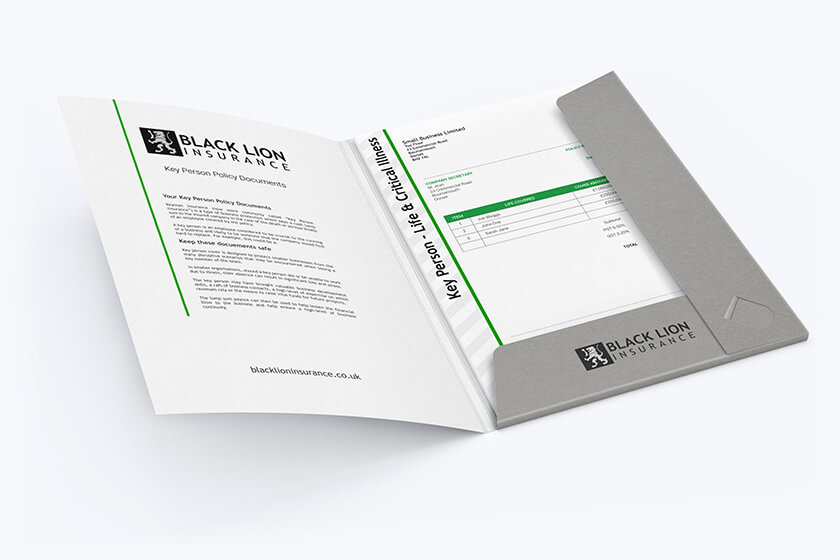
Key Person Insurance Quotes from the UK’s leading insurers
Black Lion - Part of Movo H & L

Compare The UK’s Top Insurers
Receive Quotes From The Whole Market
Compare Top UK Insurers
What Is Key Person Insurance?
Key Person Insurance (previously commonly called “Keyman Insurance”) is a type of life insurance and business protection.
It provides financial protection against the many disruptive scenarios that may be encountered when losing a key member of the team.
It pays a cash lump sum to the business in the event of the death or serious illness of the insured employee.
In the UK, policies can be taken out by a limited company, a limited liability partnership, or a sole trader.


Who Qualifies as a Key Person in a Business?
A key person is an employee considered crucial to the running of a business and likely to be someone that the company would find hard to replace. For example, this could be a:
- Business owner or chief executive
- Company director
- High-performing salesperson or business development manager
- Senior employee with business-critical responsibilities, such as an IT manager, product designer, or head engineer
What can a key person payout be used for?
Policies are often put in place with business continuity in mind. Funds can be used to hire consultants and temporary staff, recruitment of a permanent replacement, training and outsourcing. Insurance providers generally do not place restrictions on what a key person insurance payout can be used for within the business. However, what a payment is intended for will determine how premiums and payouts are taxed. A payouts are often used to repay outstanding business loans, although this is likely to have different tax implications. Theoretically, the payout could even be used by the company to purchase any shares bequeathed by a deceased key person, although in this scenario, Shareholder Protection Insurance is likely to provide a far more efficient, secure, and comprehensive policy to cover this eventuality. In a worst-case scenario, key person cover could even be used to place the company into liquidation in a methodical, compliant fashion.Why do Businesses Need Key Person Insurance?
How much does Key Person Insurance cost?
Cost Factors
- Age: The older a key person is when taking out the policy, the higher the premiums are likely to be. These premiums can, though, be fixed for the duration of the policy term.
- Medical history: Pre-existing medical conditions and lifestyle factors can raise premiums.
- Role and responsibilities: The more critical the key person’s role within the business, the higher the cover required, and this will affect the cost.
- Sum Assured: The higher the required sum, the higher the monthly premium. Policy term: Short-term policies may have lower premiums than long-term policies.
- Cover Options: Level cover policies will be cheaper than inflation-linked cover. Additional cover: Adding critical illness or permanent disability protection will increase the premium.

Key Person Estimator
Get an instant estimate!
- Select the Age of the Key Employee.
- Select a cover amount between £100,000 and £1million.
- Smoker - Does the employee smoke or vape?
- Critical Illness - Is additional Critical Illness Cover required?
- Policy Term - Select how long the policy will run for*.
Please Note: Estimates provided are for illustrative purposes only. Estimates provided are for a policy with level cover and for an individual with no pre-existing health conditions. *Longer policy terms can not be reliably estimated for employees over 50.
How much should each key person be covered for?
Setting the right level of key person insurance cover requires an estimation of the financial impact their loss would have on the business. Considerations should include:- Loss of profits: Consider how the key person’s absence might affect revenue generation and profit margins. Where they play a crucial role in sales, maintaining client relationships, or the company’s operations, calculate the potential loss of profits over a 12-to-24-month period.
- Recruitment: Finding, hiring, and training a replacement can be costly. Think about expenses such as recruitment agency fees, advertising and the necessary package to attract a suitable replacement.
- Business continuity expenses: It may be necessary to hire consultants and temporary staff or outsource functions. Think about any increased marketing efforts required to maintain client confidence and stabilise the business.
- Knock-on financial impacts: Consider how the loss of the key person might lead to costs beyond their immediate responsibilities. Could their loss cause delays to projects or product launches?
- Debt obligations: Does the policy need to cover loans or other financial liabilities guaranteed by the key person?
Cover Limits
While insurers can look at any application on a case-by-case basis, they provide guidelines as to the maximum cover they may offer. These are often:- 7 – 10x Annual salary
- 2x Annual Gross profits
- 5x Annual Net profit
Adding Critical Illness Cover
When combined with critical illness cover, Keyman Insurance can offer broader protection.
If the insured key person is diagnosed with a serious illness, the policy provides the business with a lump sum. This can help businesses manage during a key employee’s prolonged absence due to illness.
Adding critical illness insurance to a policy can increase premiums considerably; this is highly dependent on the insured individual’s age and medical history. Given that many of the critical illnesses covered could cause a prolonged or permanent absence from work, many businesses request this as standard.
List of Critical Illnesses
The list of critical illnesses covered in a policy’s conditions can vary, and it is important to understand what is and is not covered. The severity of the illness will also be defined to make the assessment of any claim as black and white as possible. For example, cancers that are caught early and are easily treatable are unlikely to be covered. It is, therefore, advisable to check and compare the list of critical illnesses in any Key Person quote.
Key Person Income Protection
Key Person Quotes
Key Person Life Insurance Quotes
Last updated:
Example Monthly Premiums for Key Person Life Insurance based on age, occupation, and sum assured for a non-smoking individual with no pre-existing health issues.
| Policy Type | Age | Occupation | Sum Assured | Monthly Premium |
|---|---|---|---|---|
| Key Person Life | 30 | Software Developer | £100,000.00 | £6.10 - £8.40 |
| Key Person Life | 40 | Sales Director | £100,000.00 | £9.70 - £11.20 |
| Key Person Life | 50 | Chief Executive | £100,000.00 | £17.95 - £24.99 |
Key Person Life & Critical Illness Insurance Quotes
Last updated:
Example Monthly Premiums for Key Person Life & Critical Illness Insurance based on age, occupation, and sum assured for a non-smoking individual with no pre-existing health issues.
| Policy Type | Age | Occupation | Sum Assured | Monthly Premium |
|---|---|---|---|---|
| Key Person Life & Critical Illness | 30 | IT Programmer | £100,000.00 | £36.00 - £42.00 |
| Key Person Life & Critical Illness | 40 | Sales Director | £100,000.00 | £57.00 - £69.00 |
| Key Person Life & Critical Illness | 50 | Chief Executive | £100,000.00 | £94.00 - £120.00 |
Key Person Income Protection Insurance Quotes
Last updated:
Example Monthly Premiums for Key Person Income Protection based on age, occupation, and monthly benefit for a non-smoking individual with no pre-existing health issues.
| Policy Type | Age | Occupation | Monthly Benefit | Monthly Premium |
|---|---|---|---|---|
| Key Person Income Protection | 30 | IT Programmer | £10,000.00 | £54.00 |
| Key Person Income Protection | 40 | Sales Director | £10,000.00 | £115.00 |
| Key Person Income Protection | 50 | Chief Executive | £10,000.00 | £350.00 |
Please Note: Example monthly premiums are intended for illustrative purposes only and to assist readers better understand and compare the potential price differences between the insurance policies listed. These quotes are not personalised or tailored to specific individual circumstances and may not reflect the actual monthly premium or terms that an individual with a similar overview may receive. For accurate, up-to-date advice and personalised quotes readers should contact Black Lion Insurance.
How is Key Person Insurance taxed in the UK?
How key person insurance is taxed in the UK can depend on the purpose of the policy and how the business intends to or subsequently uses any monies received. Companies should always speak with their accountant or obtain tax advice before putting a policy in place.
1. Corporation Tax Deductibility on Premiums
HMRC may assess the overall purpose of a policy to determine whether the premiums are an allowable business expense and therefore afforded corporation tax relief. Premiums are more likely to be allowed corporation tax relief if the policy covers a short-term period (typically five years or less).

Generally Allowable
Policies intended to protect a business from short-term financial losses due to the death or incapacity of a key person. For example, these could include:- Hiring consultants to ensure the successful completion of contracts
- Funding the recruitment costs required to find and replace the vacant position
- Training costs to fill the skill gap
- Outsourcing critical functions to ensure business continuity
- Marketing and PR focused on customer retention or to mitigate any loss of confidence or reputation
- Compensating customers for any delays or disruptions
- Covering associated legal and regulatory costs
Generally Disallowed
If the policy provides long-term benefits, such as compensating shareholders or paying off outstanding loans, HMRC sees these as capital-related costs, which don’t qualify as regular business expenses. These could include:- Buyout of shares held by the key person
- Making loan repayments or repaying any commercial debt
2. Tax Treatment of Payouts
In most cases, the tax treatment applied to any lump sum payout will depend on whether the premiums were treated as a deduction.- Tax-free: If no deduction was claimed for the premiums, the payout should be free from tax.
- Taxable: If the premiums were deducted as a business expense, HMRC is likely to treat the payout as taxable trading income.
Practical Steps for Businesses
- Keep records of why the policy was taken out and how it aligns with business protection.
- Consider separate policies if any lump sum payment would be used for both short-term business continuity and to pay off business debts.
- Always consult a qualified tax advisor to ensure compliance and optimize your tax position.
Disclaimer: The information provided on this page regarding key person protection policies and their tax implications is intended for general informational purposes only and should not be construed as tax advice. Tax regulations are complex and subject to change. The impact of tax laws and regulations can vary based on individual circumstances and may differ based on various factors. Before making any decisions, it is essential to consult qualified independent advice from a tax advisor or accountant to understand any tax implications. Black Lion Insurance does not provide tax, legal, or accounting advice. All content is provided without any warranty, express or implied, regarding its accuracy, completeness, or applicability to your specific situation.

